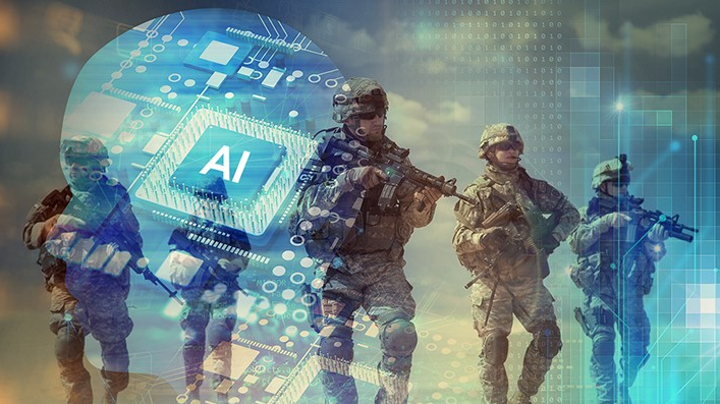The combination will be be leveraged simultaneously to maximize combat success
Under heavy enemy fire, a dismounted squad of soldiers encounters incoming sniper fire from a building and rapid movements behind certain windows, when a nearby drone is instantly and automatically tasked with quickly surveilling the area before aggregating data and propagating live-saving, combat-sensitive information directly back to commanders and soldiers.
How could it be possible, in a nearly instantaneous fashion, to circumvent or avoid otherwise time-consuming communications channels and procedural impediments to the immediate tasking of an attack drone?
One answer, now being explored in cutting edge research by scientists with the Army Research Laboratory, is to measure, process, analyze and transmit electrochemical signals from the human brain.
“We are working on adapting a sensor that would measure elements of brain activity,” John Touryan, researcher, cognitive neurosciences at Army Research Laboratory, told The National Interest in an interview.
By integrating mobile eye-tracking sensors into soldier-worn glasses, Army scientists are developing AI-enabled algorithms able to receive electrical impulses from the brain to instantly identify “a-ha” moments or responses of significance. When the eye catches something of interest, Touryan explained, it generates an electrical response in the brain which can then be measured, calculated, processed, and, as he put it, propagated.
“When people are visually engaging with the environment, they naturally identify things and objects of interest that are mission or task relevant. We want to know if we can measure that or infer that,” Touryan, whose unit is part of Combat Capabilities Development Command, Army Futures Command, said.
From here, we can begin to discern the elements of the process. Sensors monitoring the electrical activity in the brain detect an “a-ha” moment or specific visual response to a soldier’s surrounding environment. That electrical signal, impulse or indicator is then gathered and analyzed by an AI-enabled system to make immediate calculations depending upon a wide range of variables to include nearby terrain, weather, the soldier’s physiological condition and indications from other soldiers in the squad.
Advanced algorithms can accumulate information and perform analytics in the aggregate to compare and analyze. Drawing upon input from the human brain, machines can then learn to assimilate and process new information, something of great value should the database encounter something it does not recognize.
“What are the dynamics of the mission that we can understand from the brain activity of the squad so that we can adapt? We also want to understand intent and higher level concepts and emotional states,” Touryan explained.
The electrical process happens so quickly, that signals can be detected and transmitted even before a human brain is cognitively aware of what it has seen. The process works so well, in part, because most AI systems are, generally speaking, inspired by and based upon the biological structures of the vision nerves of mammals, Army scientists said.
The object of interest seen can then instantly be analyzed, processed and transmitted to a computer equipped with a vast database of potential responses or scenarios. Perhaps the AI-empowered system instantly recognizes that the objects of interest to soldiers are in fact enemy fighters by bouncing the information off of a known database identifying shapes, contours, movements and atmospheric conditions such as thermal signatures. Following this analysis, a drone is automatically dispatched to assess the points of relevance, taking the best and most immediate actions needed for the particular circumstance.
“We want to use AI and humans as part of a dynamic system broadly speaking, so that when a new situation arises on the battlefield, we can adapt to that information and that information is then propagated across the system, so resources can be dedicated at the point of need to solve the problem immediately,” Touryan said.
The combination or merged attributes of man and machine can, as the thinking goes, be leveraged simultaneously to maximize combat success.
“Humans are very good at understanding dynamic environments as things change. Algorithms are traditionally very rigid. We are now bringing in new information from a human adapting to a new environment. Now we can provide that information quickly to an AI system which will be able to adapt to a new thing and understand why it is relevant to a human,” Touryan said.
Touryan explained the neuroscientific basis for how these kinds of sensors are possible.
“The brain consumes a lot of energy. We convert energy from food proteins that are then used to create voltage imbalances, which then lead to electrical discharges. We call them spikes. The brain spikes activity, tiny electrical signals which neurons use to communicate with each other. They are electrical-chemical reactions,” he said.
The tactical premise here is to synergize, integrate and combine the best attributes of machines and humans together to optimize combat success.
“We want to understand soldiers as they are reacting to the world, so that AI can become a teammate and not a tool,” Touryan said.













![Hotstar Premium Cookies 2019 [*100% Working & Daily Updated*] Hotstar Premium Cookies 2019 [*100% Working & Daily Updated*]](https://tahav.com/wp-content/uploads/2019/11/Hotstar-Premium-Cookies-Free-100x70.jpg)



